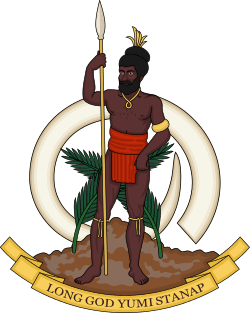Languages of Vanuatu
| Languages of Vanuatu | |
|---|---|
| Official languages | English, French, Bislama |
Vanuatu has three official languages, English, French, and Bislama, a creole language derived from English. Bislama is the first language of many urban ni-Vanuatu, that is, the residents of Port Vila and Luganville. It is the most common second language elsewhere in the Vanuatu islands. It is similar to Tok Pisin of Papua New Guinea, and other nearby creoles.
In addition, there are over one hundred local languages spread over the archipelago. Vanuatu is the country with the highest density of languages per capita in the world: it currently shows an average of about 1760 speakers for each indigenous language, and went through a historical low of 565;[1] only Papua New Guinea comes close. Some of these languages are very endangered, with only a handful of speakers, and indeed several have become extinct in recent times. Generally however, despite the low numbers for most of the indigenous languages, they are not considered especially vulnerable for extinction.[2]
In recent years, the use of Bislama as a first language has considerably encroached on indigenous languages, whose use in the population has receded from 73.1 to 63.2 percent between 1999 and 2009.[3]
Out of the three official languages, Bislama is the most spoken in Vanuatu, followed by English, and lastly French.
English and French
From the times when Vanuatu used to be an English-French condominium, there is still an unofficial separation line between regions where English or French are taught at school. According to Ethnologue, English is spoken by 1,900 inhabitants (1995), and French by 6,300 inhabitants (1995). Both English and French remain second languages, while Bislama is a principal language for most inhabitants.
Indigenous languages
Vanuatu is home to more than a hundred indigenous languages: a recent count lists 138.[4] Among them, three became extinct in recent decades. Many are named after the island they are spoken on, though some of the larger islands have several different languages. Espiritu Santo and Malakula are linguistically the most diverse, with about two dozen languages each.
Some language names refer to networks of dialects rather than unified languages. Uripiv, for example, is a dialect continuum spoken across several islands in Malampa Province. In such cases, the decision as to how many languages should be counted is notoriously difficult, and sometimes the object of controversy. The number of 112 listed below may differ from other counts proposed in the literature, depending partly on these difficulties.[5]
All indigenous languages of Vanuatu are Oceanic. Three are Polynesian languages of the Futunic group: Emae, Mele-Fila and Futuna-Aniwa. The remaining languages belong to various branches of the Southern Oceanic branch of Oceanic.
List
Below is a list of most of the indigenous languages of Vanuatu, which are still spoken or were until recently.[6] It provides links to corresponding Ethnologue entries and to an OLAC list of media resources on the language.[7]
Tip: Click on the column title to change the sort order.
Notes
- ↑ See François et al. (2015:8-9); and also Crowley (2000:50); François (2012:86).
- ↑ Nettle, Daniel and Suzanne Romaine (2016). Vanishing Voices: The Extinction of the World's Languages. Oxford: Oxford University Press. p. 9. ISBN 0-19-515246-8.
- ↑ François (2012:104).
- ↑ See François et al. (2015).
- ↑ Thus while Tryon (1976) lists 113 separate languages, Lynch & Crowley (2001), using different criteria, propose a lower figure of 88 languages, many of which are dialect continua. See the discussion in François et al. (2015:4-7).
- ↑ This table lists 112 languages. See François et al. (2015:18-21) for a list of 138 items.
- ↑ The bibliographical references that underlie this table can be found with each individual language entry.
References
- Crowley, Terry (2000), "The language situation in Vanuatu", Current Issues in Language Planning, 1 (1): 47–132
- François, Alexandre (2012), "The dynamics of linguistic diversity: Egalitarian multilingualism and power imbalance among northern Vanuatu languages", International Journal of the Sociology of Language, 214: 85–110, doi:10.1515/ijsl-2012-0022 .
- François, Alexandre; Franjieh, Michael; Lacrampe, Sébastien; Schnell, Stefan (2015), "The exceptional linguistic density of Vanuatu" (PDF), in François, Alexandre; Lacrampe, Sébastien; Franjieh, Michael; Schnell, Stefan, The Languages of Vanuatu: Unity and Diversity, Studies in the Languages of Island Melanesia, Canberra: Asia Pacific Linguistics Open Access, pp. 1–21, ISBN 9781922185235 .
- Lynch, John; Crowley, Terry (2001). Languages of Vanuatu: A new survey and bibliography. Research School of Pacific and Asian Studies. ISBN 0-85883-469-3
